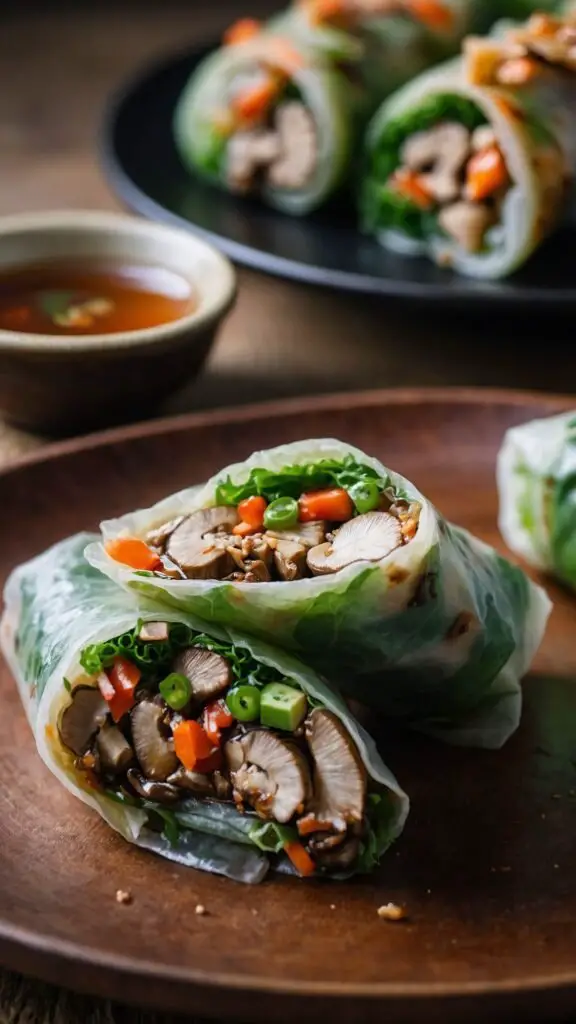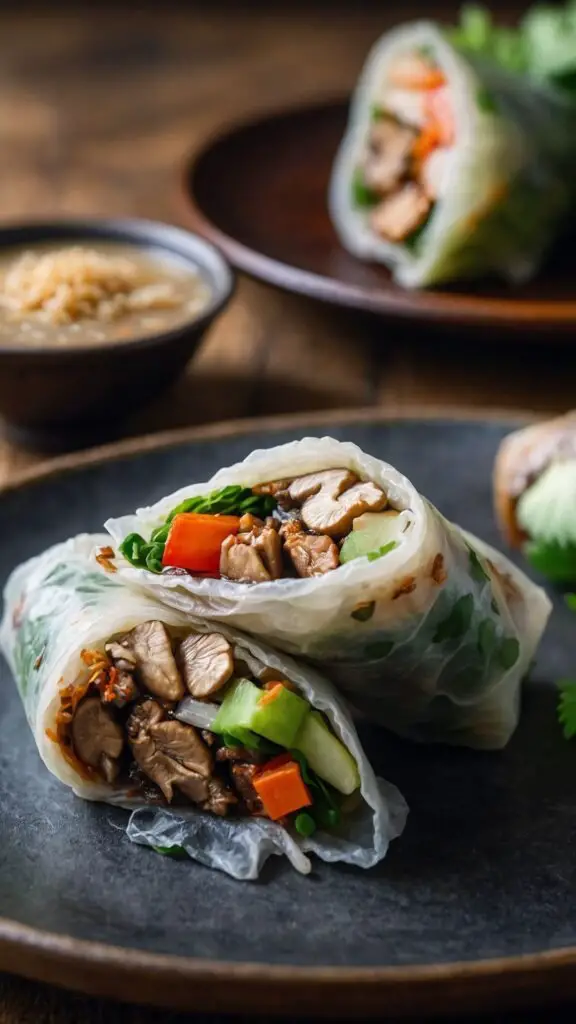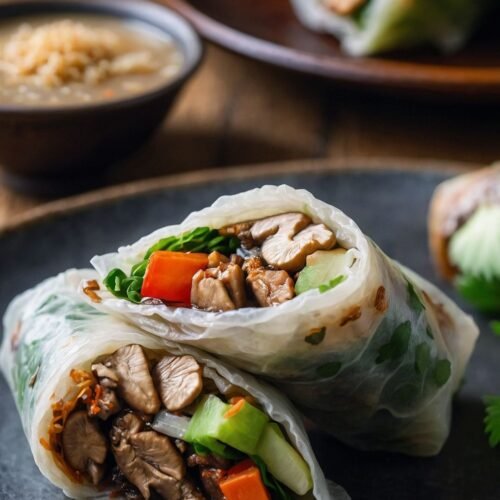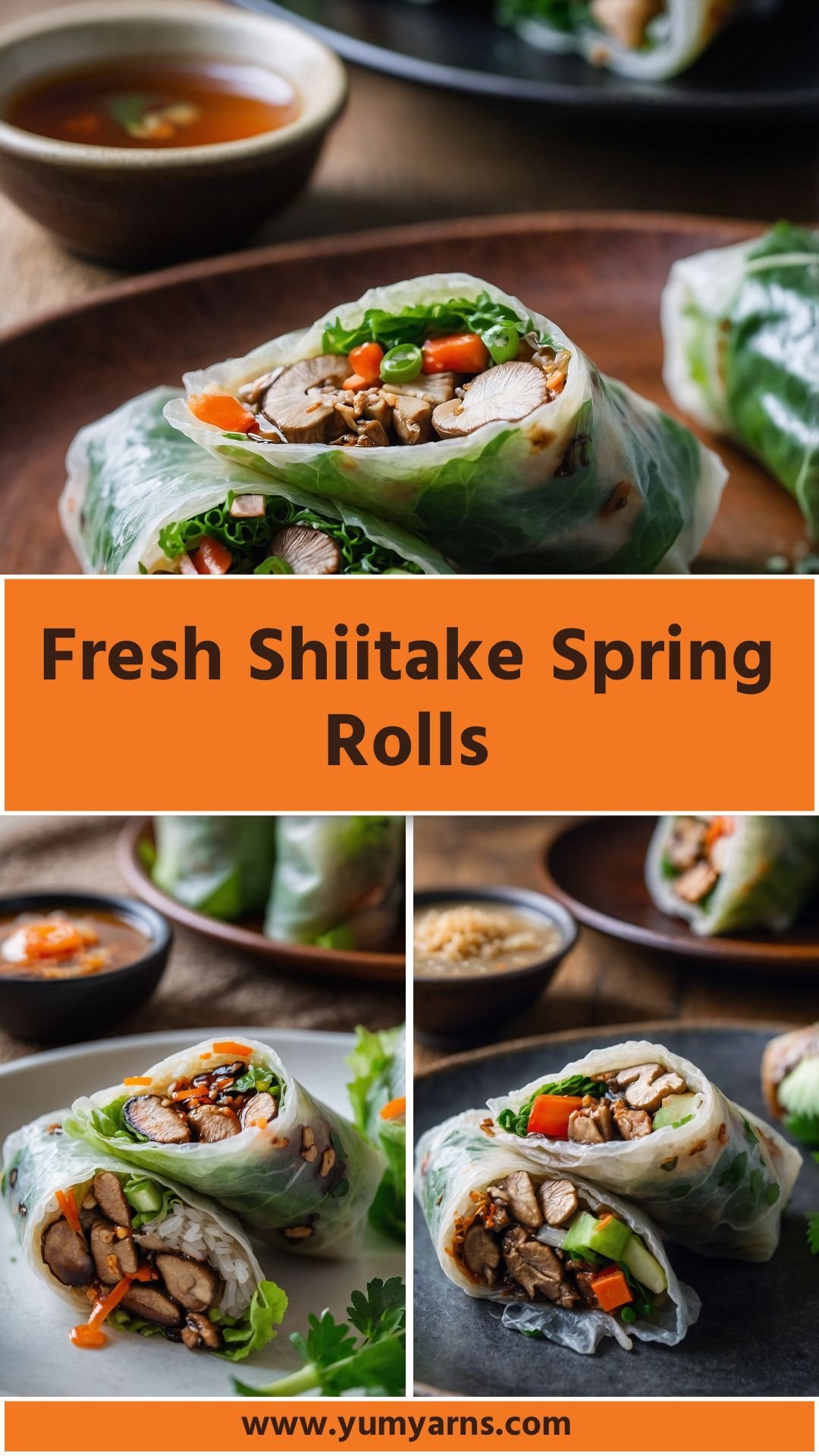In Vietnamese cuisine, fresh spring rolls are a versatile delight. You can elevate your meal by serving these rolls alongside a variety of sides. Here are a few to consider:
- Nuoc Cham Dipping Sauce: This classic Vietnamese sauce combines fish sauce, vinegar, sugar, garlic, and chili. It brings a tangy sweetness that perfectly complements the freshness of the rolls.
- Thai Peanut Sauce: For a richer taste, try a homemade peanut sauce. Its creamy texture and nutty flavor create a lovely contrast to the crunchy veggies and tender shiitake mushrooms.
- Citrusy Herb Salad: A light salad made with fresh herbs like cilantro, mint, and lime juice can brighten the meal and enhance the flavors of your spring rolls.

Adventure Begins: Fresh Shiitake Spring Rolls
Imagine a warm evening, the sun setting, and the air is filled with the sounds of laughter. You gather with friends and family, eager to share something delicious. That’s when you’ll want to whip up fresh shiitake spring rolls. They are not just a dish; they’re a way to bring everyone together. Think of them as edible presents. Each bite is a surprise waiting to be discovered.
Spring rolls shine as portable snacks or light appetizers, and they boast the all-important “fresh” factor. When you bite into them, you experience that satisfying crunch combined with an explosion of flavors. But they’re more than just good eats; they also open the door to a wider culinary journey.
Why This Recipe Works
1. A Variety of Textures: The combination of crispy vegetables, tender shiitake mushrooms, and chewy rice wrappers creates a delightful mix. Each bite offers crunch, softness, and everything in between.
2. Nutrient-Rich Ingredients: Packed with fresh produce like bell peppers and avocado, these spring rolls are a feast for your health. Shiitake mushrooms are known for their immune-boosting properties, adding another layer of nutrition.
3. Quick Preparation Time: Busy weeknight? No problem! This recipe comes together in minimal time. With just a little prep work, you can enjoy these delicious rolls in no time.
4. Customizable Flavors: Want to spice things up? Feel free to swap in your favorite vegetables. You’re in control, so get creative and discover flavors you love.
How Does It Taste?
The taste of fresh shiitake spring rolls is hard to describe in words alone; it’s an experience. Imagine biting into a roll and feeling the crispness of the vegetables, followed by the earthiness of the shiitake mushrooms.
The blend of fresh herbs like basil and cilantro adds a refreshing bouquet. Paired with a dipping sauce, each bite becomes a savory journey.
You will also like the following Lunch and Dinner recipes!
- How to make Deviled Eggs
- Schnitzel Over Buttered Spätzle with Sweet and Sour Cabbage Recipe
- Copycat Spicy Thai Red Curry Soup
What Sets This Recipe Apart?
This version of fresh shiitake spring rolls stands out because of the balance in flavors. Many recipes may rely heavily on one or two ingredients, but this recipe incorporates a range of vibrant vegetables and herbs. You won’t just taste the mushrooms or the sauce; each ingredient interacts harmoniously, making for a well-rounded dish.
The Ingredients
For these fresh shiitake spring rolls, you’ll need:
- 1 block of cooked rice noodles (you can also use vermicelli)
- ¼ cup cooked rice noodles
- 2 tablespoons chopped cashews for crunch
- 2 tablespoons spicy almond-coconut sauce, for a kick
- 1 tablespoon olive oil, or you can use vegetable broth for sautéing
- ½ cup sliced shiitake mushrooms
- 4-5 slices of various bell peppers (red or yellow for color)
- 3 slices of ripe avocado for creaminess
- 1 teaspoon freshly chopped basil for that vibrant flavor

Instructions
Step 1: Prepare the Noodles
Start by cooking the rice noodles according to the package instructions. It’s essential to rinse them under cold water to stop the cooking process and keep them from getting sticky.
Step 2: Sauté the Shiitake Mushrooms
In a skillet, heat olive oil over medium heat. Add the sliced shiitake mushrooms and cook until they’re tender and fragrant. This won’t take long, just about 3-4 minutes. The goal is to develop their natural umami flavor.
Step 3: Assemble the Rolls
Lay out a damp rice wrapper on a clean surface. Layer the cooked noodles, sautéed shiitake mushrooms, and colorful bell pepper slices. Don’t forget the avocado and some chopped basil for freshness.
Step 4: Roll Them Up
Starting from one end, carefully roll the wrapper over the filling. Tuck in the sides as you go to create a secure roll. Keep things tight, but not so tight that the wrapper tears.
Step 5: Serve with Dipping Sauce
Once your rolls are assembled, cut them in half for presentation. Serve alongside your choice of dipping sauce and watch everyone delight in this culinary creation.
Notes
Here are a few tips to make your spring roll experience even better:
- Keep Wrappers Covered: Rice wrappers can dry out quickly. Keep them covered with a damp cloth while you work to prevent this.
- Use Room Temperature Ingredients: To avoid tearing the rice paper, let your fillings reach room temperature before using them.
- Experiment with Sauces: Don’t hesitate to try different dipping sauces. A hoisin mix or soy sauce can also add great flavors.
- Use Fresh Agar or Tofu: If you want to keep it plant-based, swap in some fresh tofu or agar for additional texture.
- Don’t Overfill: It might be tempting, but resist the urge to overstuff your rolls. Too much filling can lead to breakage.
Nutrition Information
For nutrition information, consider that each roll may vary based on specific ingredients and how you assemble them, but here’s a rough estimate:
- Calories: Approximately 150-200 per roll
- Protein: 4-5g
- Carbohydrates: 25-30g
- Fat: 6-8g

How Do You Store Fresh Shiitake Spring Rolls?
Fresh rolls are best enjoyed right away. If you need to store them, put them in an airtight container with a damp cloth to keep the wrappers from drying out. Consuming them within a day or two is ideal for maintaining their texture and flavor.
Sides for Fresh Shiitake Spring Rolls
When serving these rolls, consider these great side options:
- Vietnamese Slaw: A crunchy cabbage slaw with carrots and a zingy dressing pairs well. The freshness complements the rolls, adding more texture and flavor.
- Chilled Edamame: Lightly salted, these green delights are high in protein and provide a satisfying little bite to round out the meal.
- Cucumber Salad: A simple cucumber salad with rice vinegar, sesame oil, and sesame seeds offers freshness and lightness, balancing the heavier flavors of the rolls.
Alternatives for Ingredients
No spring roll is the same, and substitutions can lead to exciting discoveries. Here are some ingredient alternatives:
- Mushroom Substitute: If you can’t find shiitake, feel free to use other mushrooms like portobello or cremini for a similar texture.
- Rice Noodles: If unavailable, try substituting with thin soba or buckwheat noodles. They will bring unique flavors and density.
- Bell Peppers: Swap in other crunchy veggies like jicama or cucumber for crunch.
- Nut Sauce Alternatives: If you are allergic to nuts, consider using tahini or sunflower seed butter for a different creamy effect in your sauce.

Fresh Shiitake Spring Rolls
Equipment
- Skillet
Ingredients
- 1 block of cooked rice noodles you can also use vermicelli
- ¼ cup cooked rice noodles
- 2 tablespoons chopped cashews for crunch
- 2 tablespoons spicy almond-coconut sauce for a kick
- 1 tablespoon olive oil or you can use vegetable broth for sautéing
- ½ cup sliced shiitake mushrooms
- 4-5 slices of various bell peppers red or yellow for color
- 3 slices of ripe avocado for creaminess
- 1 teaspoon freshly chopped basil for that vibrant flavor
Instructions
Step 1: Prepare the Noodles
- Start by cooking the rice noodles according to the package instructions. It’s essential to rinse them under cold water to stop the cooking process and keep them from getting sticky.
Step 2: Sauté the Shiitake Mushrooms
- In a skillet, heat olive oil over medium heat. Add the sliced shiitake mushrooms and cook until they’re tender and fragrant. This won’t take long, just about 3-4 minutes. The goal is to develop their natural umami flavor.
Step 3: Assemble the Rolls
- Lay out a damp rice wrapper on a clean surface. Layer the cooked noodles, sautéed shiitake mushrooms, and colorful bell pepper slices. Don’t forget the avocado and some chopped basil for freshness.
Step 4: Roll Them Up
- Starting from one end, carefully roll the wrapper over the filling. Tuck in the sides as you go to create a secure roll. Keep things tight, but not so tight that the wrapper tears.
Step 5: Serve with Dipping Sauce
- Once your rolls are assembled, cut them in half for presentation. Serve alongside your choice of dipping sauce and watch everyone delight in this culinary creation.
Notes
- Keep Wrappers Covered: Rice wrappers can dry out quickly. Keep them covered with a damp cloth while you work to prevent this.
- Use Room Temperature Ingredients: To avoid tearing the rice paper, let your fillings reach room temperature before using them.
- Experiment with Sauces: Don’t hesitate to try different dipping sauces. A hoisin mix or soy sauce can also add great flavors.
- Use Fresh Agar or Tofu: If you want to keep it plant-based, swap in some fresh tofu or agar for additional texture.
- Don’t Overfill: It might be tempting, but resist the urge to overstuff your rolls. Too much filling can lead to breakage.
Nutrition
Frequently Asked Questions
1. Can I prepare these spring rolls in advance?
Yes! You can prep the filling and store it in the fridge for a couple of days. However, it’s best to assemble the rolls shortly before serving to keep them fresh.
2. Are these spring rolls gluten-free?
Yes! Ensure you use rice paper wrappers and gluten-free noodles. Check all sauces for gluten-containing ingredients to keep it safe.
3. Can I freeze fresh spring rolls?
It’s not recommended to freeze fresh rolls, as the rice paper can become tough and unappetizing upon defrosting. Stick to refrigerating for short-term storage.
4. What’s the best way to slice these rolls?
Using a sharp knife, slice the rolls in half diagonally. This ensures a clean cut, making them easy to dip and preventing the filling from spilling out.
Conclusion
Now that you’ve learned the ropes of crafting fresh shiitake spring rolls, it’s time to roll up your sleeves and get cooking! This recipe offers flexibility, nutrition, and a symphony of flavors.
So, gather your ingredients, invite some friends over, and enjoy the delightful experience of making and sharing these incredible rolls. Trust me, each roll is a celebration of flavor, a burst of health, and a testament to the joy of good food enjoyed together. Happy rolling!

